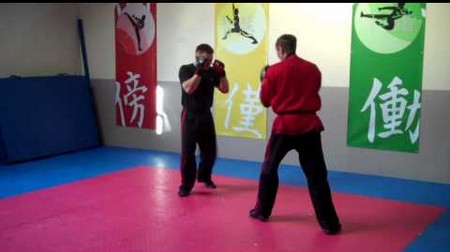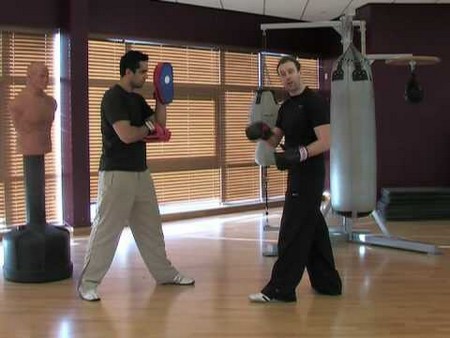Half the battle of studying a martial art is pushing yourself to be in the best shape you can—and if you don’t push yourself, your instructor will. That’s not to say you’ll be ridiculed if you can’t do twenty push-ups in a row, or if you can’t fall gracefully into a split. But you are expected to try. Attitude counts almost as much as physical ability. Put effort into your workout, and you’ll build strength, increase stamina and speed, and improve flexibility beyond your own expectations.
Indeed, strength, stamina, speed, and flexibility are the building blocks of the martial arts. Understanding the role they play in training will help you understand the physical characteristics that make up just about every style of martial
In the martial arts, strength is developed through warm-up exercises performed before class, as well as through drills practiced during class. A common misunderstanding among nonmartial artists is that bulk equals strength. It doesn’t in this sport. Look at any martial arts veteran; you won’t see strength, although you know it’s there. You could feel it if she were to punch you, grab your wrist, or sweep you with her foot. You can see it as she spars; the fast, hard techniques she wields, as well as the control she exercises as she throws a punch that stops just short of hitting her opponent. You can also hear strength. Listen as students perform punching drills. When done correctly, their uniforms will “snap” every time they unleash a punch.
Bulk is not only unnecessary in the martial arts, but can actually be a drawback because it tends to decrease flexibility. Still, some students continue to pump up at the gym, then come to class expecting to be the star pupil. But for every inch they gain in their physique, they lose in terms of flexibility— a trait as important in the martial arts as strength. When you observe a class, look for a muscular type and watch how he performs. If he’s sparring, for example, his kicks are probably low, and he doesn’t use his hips to help propel his punches. He probably stands in one place and throws a punch or two whenever the opponent comes in. He’s like a punching bag with arms. This is not the martial arts.
Female students shouldn’t be impressed or mtimidated by their muscular martial arts counterparts. When you’re paired with a muscle-bound student, use speed and timing to avoid hits from him. As he withdraws a technique, come in and throw your own, then get out. Keep in mind, however, that muscular students may not have the control to stop a technique just short of lutting a target. Taking a hit from one of these students will almost surely result in an injury. You’re not expected to take this. If you’re paired with a student whom you think can’t control his techniques, keep your distance and don’t take chances. Wait until you’re paired with someone you trust.
Certainly, you’re not expected to risk injuring yourself in the name of excelling in the martial arts. However, it’s easy to get so caught up in your training that you take chances you wouldn’t normally take. It’s also common to allow your training to become all-consuming. There is a strong element of competition within most schools. Students who start training to learn something new and stay in shape soon become caught up in the pressure to not only keep up but excel.
But while no student is expected to be the best and the brightest, many nevertheless go to great lengths to achieve that status. To that extent, they’ll supplement their training by joining a gym or health club, or running or cycling. Admittedly, when I started my martial arts training, as a former health club attendee, I was struck by the absence of weights and Nautilus equipment in my karate school. The training floor was barren, except for some punching bags and pads. Instead of interacting with machines and objects, students, for the most part, work with each other. What soon became apparent is that you don’t need steel and iron to build strength; the resistance generated between two human beings is as effective in building muscle as pressing weights.
When done properly, working out with weights can improve strength, while not limiting flexibility. Some schools even make weights available to students. Years ago, I invested in a set of six-pound free weights, which I use while watching television. The reps I did conditioned me so that I could better keep up with push-ups and other in-class warm-up exercises.
I also took up running. Although I never ran more than three miles a week, it was enough to help me develop stamina. Unfortunately, my knees couldn’t take the stress of both running and martial arts training. As a result, I limited my running to when I needed its benefits the most, which was usually several weeks before I would be tested for a promotion.
Schools that don’t make weights available to students are likely to incorporate traditional training equipment into their curriculums.
No matter how many students in your class supplement their training, don’t feel pressured to do the same. Certainly, you’ll run into students totally immersed in their martial arts training—taking class four times a week, training at a twice weekly, assisting the instructor with children’s classes, and competing in tournaments. Then mere will be students who attend class two or three times a week, improving at slow increments, but content with their progress.
e tendency is to get caught up in a sort of training frenzy, competing to be the strongest and fastest, and to have the most endurance. Don’t let it get the best of you. Decide before you start training what role you want the martial arts to play in your life. Most of the women—from single careerists to full-time homemakers—I’ve trained with took up a martial art to ance their lives, not complicate them. Neither competition nor a drive to be the star pupil attracted them to the martial arts. They attended class two or three times a week, and rarely trained outside class. Those who didn’t sway from those principles were more likely to stick with their training and enjoy it.
When you consider the rigorous training a martial arts school provides, there’s almost no reason to seek additional training. The basic, no-frills exercises most instructors depend n are effective. Push-ups for the upper body, sit-ups or crunches for the abdomen, and squats for the legs do wonders for strengthening and sculpting the body.
Sound boring? It might if instructors didn’t add their own variations to these exercises. My instructor “enhances” pushups by having students perform them on their fingertips— something I never mastered. Variations for sit-ups done with knees bent and feet flat on the floor include twisting so each elbow touches the opposite knee, or simply holding your torso in midair, two or three inches from the floor, for a minute or two. And because my style of martial arts incorpo-tes kicks, the instructor has students kick as they rise from arm-up squats. Again, remember effort. I rarely keep up when it comes to push-ups, but I try. Sometimes I lie exhausted and weak on
my stomach with my forehead on the floor as others around me push up and down, up and down, and I wonder how I ever got myself in such a predicament. One exercise I never managed to perform well even once involves sitting up on the floor with both legs sticking straight out and palms flat on the floor. The idea is to raise and hold yourself off the floor using only your hands for support. But while I can’t do it (I still suspect it’s done with mirrors), I can honestly say I’ve tried.
Warm-ups are such an integral part of the martial arts that some schools become famous for them. My school’s specialty includes having students drag themselves across the floor using only their hands. Lying on your stomach, you reach up with both hands, slap the floor, then pull yourself forward— using your feet is not allowed. Not only did this build the upper body, but it cleaned the floor as well!
While individual training is probably the most common form of martial arts framing, one-on-one training is doubly effective because in addition to building strength, it familiarizes students with how to work with one another—something you’ll certainly be expected to do. Again, basic exercises, some of which you may have done in gym class as a grade-school student, will once again whip you into shape. Among them: wheelbarrows, sit-ups during which one person holds your feet, and leg lifts during which one partner pushes the legs down as you bring them up. m addition, you might perform resistance training with a partner in which you both push against each other’s force. While perforrning these exercises with a partner is physically challenging, the challenge that lies in learning to work with a partner can be just as great.
I can’t think of any sport in which male and female students work as closely together as in the martial arts. While you might expect a high degree of unease among males and females to be limited to teen classes, adult classes have their share of male students who are uncomfortable working with women, and vice versa. I’ve seen perfectly normal, intelligent people become flustered and jittery when paired with someone of the opposite sex. I’ve also seen pairs of students become so aggressive during warm-ups that in their zeal to outdo each other, the workout actually becomes dangerous.
Hypothesizing about why these problems arise isn’t constructive. What’s important to remember is that you will be expected to work with just about every student in your class. It’s not your instructor’s way of acquainting students with one another; it’s done for practical reasons, such as conditioning yourself to perform techniques on partners of different sizes and strengths. Keep this in mind if your instructor should ever pair you up with a six-foot, 200-pound-plus partner.
For every partner I’ve worked with who was easygoing and responsible, there was one who wasn’t. If you encounter someone who seems more intent on competing with you than working with you, speak up. A simple “Let’s take this a little slower” is usually enough to get the point across. The biggest mistake you can make is to not say anything, which is what I used to do. I often hesitated to speak up unless I was experiencing pain—and even then I’d keep quiet, thinking that it would be over soon so I might as well just endure it. Don’t make the same mistake I did.
You may find yourself working with someone who isn’t a threat physically, but seems uptight about working with you. In this case, try diverting your attention from whom you’re working with, concentrating instead on the task at hand. By showing your partner that you are more concerned with what you’re doing as opposed to who you are doing it with, the other person usually relaxes. Acquiring a knack for putting your partner at ease and making him forget he’s working with a woman is a talent you’ll carry over into other areas of your life

